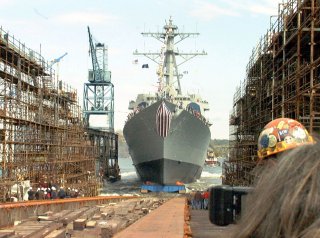The Pandemic Shows That the Navy Needs More and Better Shipyards
There is a capacity problem that the Navy must overcome to be ready no matter what happens in the world.
As the union strike at Bath Iron Works shipyard in Maine finally comes to an end, it is important for policymakers not to let up on the gas pedal to improve efficiency across the Navy. The global pandemic worsened an already troubling trend. Leaders should use this opportunity to institute changes that will last beyond the pandemic and change processes for the better permanently.
Unplanned work, which causes interruptions, along with issues like worker performance and having enough people to do the job, were top contributors to Navy ship maintenance delays before COVID-19, according to a recent report by GAO. Those exact challenges have only grown and worsened post-pandemic.
A lot of it comes down to manning. The same GAO report found overall shipyard performance was poor before the pandemic due to lower numbers of workers. For “aircraft carriers and submarines with planned completion dates in fiscal years 2015 through 2019,” the Navy’s four shipyards “[had] a combined total of 7,424 days of maintenance delay.” More specifically, the shipyards “completed 38 of 51 (75 percent) maintenance periods late.” These delays “averaged 113 days late for aircraft carriers and 225 days late for submarines,” the report said.
It isn’t just a hiring issue or lack of skilled workers. The Navy regularly “underestimated the ‘resource days’ — the number of work days per person — by 36 percent for aircraft carrier and submarine maintenance periods,” contributing “to more than 4,100 days of maintenance delays.” Manpower shortages have directly contributed to productivity slumps.
The solution was often to use overtime as opposed to grow the workforce. The result was that “shipyard officials also told GAO that production shops at the yards are working beyond their capacity, with overtime tied to a decline in productivity, peaking as high as 45 percent in the four years.” Not only is this costly, but it is an unsustainable solution for an already-stressed system.
Pile on a pandemic, and the trends look worrisome across the public and private yards. According to the Pentagon, data from industry is showing 30-40 percent inefficiency across the defense industrial base, but certain sectors like shipbuilding are experiencing 50-60 percent inefficiency. At shipyards, for example, “blue-collar worker attendance ranges from just half to 70 percent.”
Officials are “concerned with a potential loss of critical labor skills,” such as welders. Shipbuilders are in dire straits given the “significant touch labor” required to build a ship and “greater facility impact from social distancing.” The potential (albeit temporary) shutdown of one of the “big seven” private shipyards is a real risk right now.
The Virginia-class attack submarine is currently experiencing delays in its production line, as Newport News Shipbuilding has “prioritized its available workforce on supporting maintenance for in-service submarines and aircraft carriers.” If electricians, engineers and solderers shift from the Virginia assembly line elsewhere, the work is slowed and “the opportunity for the cost to come down on each successive submarine hull is diminished.”
The Navy launched a Shipyard Infrastructure Optimization Program in the fall of 2018 to address some of the issues. Service leaders acknowledge some faults at the public yards, noting “aging shipyards have been unable to adequately sustain and optimize their facilities, utilities, dry docks, equipment and information technology infrastructure. These inefficiencies and obsolete facilities result in higher maintenance costs, schedule risks and reliability issues.”
As Congress considers a fourth and likely final stimulus bill to address the pandemic response, the Navy should use this opportunity to hire more skilled workers, rely less on overtime, and update their shipyard facilities to come out in a better and stronger position after coronavirus.
This article first appeared in 2020 on the AEI Ideas blog.
Image: Reuters.

